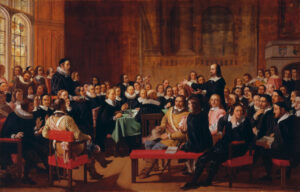“Your house has good bones,” my realtor friend recently said to me.1 I knew what he meant: the foundation and material structure of our home was carefully established using quality materials that guaranteed durable longevity. I suspect at least part of the reason was that the father of the family who previously owned our home built the house and he made sure he built his own home with “good bones.” As Christians seeking to live our lives for Christ it is important to ask: what is our foundation in the Christian life? And, if we can say it like this, are these “good bones?”
In short, the foundation for the Christian life and our pursuit of Christlikeness is our union with Christ. As Sinclair Ferguson points out, one of the amazing ways that Scripture demonstrates this is that although one would assume that the most important passages of Scripture for sanctification are those that emphasize the imperative, in actuality Scripture usually uses “the indicative rather than the imperative mood,” to “describe sanctification.”2 The most important doctrine in all of Scripture for describing the Christian’s identity is the doctrine of union with Christ. John Murray famously concluded his masterful book on the ordo salutis, Redemption Accomplished and Applied, with a chapter that is one of the greatest treatments union with Christ in the whole of Christian literature. There he argues, “apart from union with Christ we cannot view [the] past, present, or future with anything but dismay and Christless dread. [However] by union with Christ the whole complexion of time and eternity is changed and the people of God may rejoice with joy unspeakable and full of glory.”3 Union with Christ is the banner over the whole of redemption. It is “the central truth of the whole doctrine of salvation” in both “its one-for-all accomplishment in the finished work of Christ” and application of that work to the believer.4
The Puritans and Reformers believed union with Christ was the believer’s “chief blessing.”5 In his Institutes, John Calvin famously asked “How do we receive those benefits which the Father bestowed on his only-begotten Son…that he might enrich poor and needy men?” He answers, “as long as Christ remains outside of us, and we are separated from him, all that he has suffered and done for the salvation of the human race remains useless and of no value for us.” However, by uniting us with Himself, “becom[ing] ours” and “dwell[ing] within us.” he “share[s] with us what he has received from the Father.” In this way, “we come to enjoy Christ and all his benefits”6 It’s no wonder then that the chief description of a believer is not a Christian, but one who is “in Christ.”7
It is crucial, however, to carefully define what union with Christ means for the believer. In short, union with Christ is the doctrine that believers are really and mystically united to Christ by the Holy Spirit. As William Bridge says in his The Spiritual Life and In-Being of Christ in All Believers, union with Christ is the doctrine that “Jesus Christ…[is] really united to each believer by his Spirit, and really in him in this spiritual and mystical way.”8 On the one hand, this is a real union. It is the undeniable gospel reality that there is a real joining together of Christ and the believer where, by His Spirit, believers are in Him and he is in them. As Ephesians 5:30 says believers are “members of his body.” Thus, if you are a believer today, than the truth that right now you are united to Christ is every bit as real as the chair you are sitting in, the air you are breathing, the light you are seeing. However, this union is also a mystical union. Paul calls this union between Christ and His Church “profound” mystery (Ephesians 5:32) and “the mystery hidden for ages and from generations but now revealed to his saints” (Colossians 1:26). In light of this, it’s worth acknowledging that union with Christ is not something altogether explainable.
[1] This article is an expand and updated version of one section of Greg Salazar, “Growing in Christ-likeness,” in Joel R. Beeke, ed., Growing in Grace (Grand Rapids: Reformation Heritage Books, 2020).
[2] Sinclair B. Ferguson, Devoted to God: Blueprints for Sanctification (Edinburgh: Banner of Truth Trust, 2016), p.x.
[3] John Murray, Redemption Accomplished and Applied (Grand Rapids, MI: W.B. Eerdmans, 1955), p.175.
[4] Murray, Redemption Accomplished and Applied, p.171.
[5] Joel Beeke and Mark Jones. A Puritan Theology: Doctrine for Life (Grand Rapids: Reformation Heritage Books), p.483
[6] John Calvin, Institutes of the Christian Religion, ed. John T. McNeill, trans. Ford Lewis Battles (Philadelphia: Westminster Press, 1960), 3.1.1.
[7] Ferguson, Devoted to God, p.71.
[8] William Bridge, The Works of the Rev. William Bridge (5 vols.; London: Thomas Tegg, 1845; repr., Beaver Falls, Pa.: Soli Deo Gloria Publications, 1989), 1:371.



